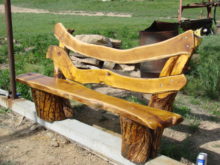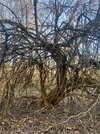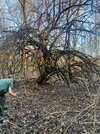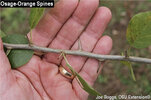You are using an out of date browser. It may not display this or other websites correctly.
You should upgrade or use an alternative browser.
You should upgrade or use an alternative browser.
Tree id
- Thread starter Cluck Norris
- Start date
- Replies 27
- Views 738
Careful...thats the one the Headless Horseman is buried under
We made the joke today that someone trapped a demon inside it.Careful...thats the one the Headless Horseman is buried under
It’s reminds me of the tree from earnest saves Halloween.
It definitely looks like its a tortured soul lol
@RedneckFur You're up!
Dang, make it easy on us with no leaves!
Honestly the shape reminds me of an Osage Orange, aka Bois d'arc or maybe what is called hedge, but I am not sure they grow in the Carolinas.
If it is, it will have a grapefruit size fruit with a weird texture. Growing up in SE PA/northern DE we called them monkey balls.
Honestly the shape reminds me of an Osage Orange, aka Bois d'arc or maybe what is called hedge, but I am not sure they grow in the Carolinas.
If it is, it will have a grapefruit size fruit with a weird texture. Growing up in SE PA/northern DE we called them monkey balls.
We also have hemlocks on the property and they aren’t supposed to be here eitherDang, make it easy on us with no leaves!
Honestly the shape reminds me of an Osage Orange, aka Bois d'arc or maybe what is called hedge, but I am not sure they grow in the Carolinas.
If it is, it will have a grapefruit size fruit with a weird texture. Growing up in SE PA/northern DE we called them monkey balls.
Looks like a damn Russian Olive to me. We call them 'face whackers'
I don’t remember seeing any, we’re walking back that way tomorrow to cut cedars for fence posts I’ll check and seeWell let’s filter some things out, does it have big thorns?
No thorns, it’s neither hedge (osage orange) nor russian olive.I don’t remember seeing any, we’re walking back that way tomorrow to cut cedars for fence posts I’ll check and see
RedneckFur
Smith & Wesson is a religion of peace.
That is an Osage orange! They do grow naturally in the northern piedmont, but they're not very common. It produces a big green fruit about the size of a grapefruit. It is edible, but it tastes pretty bad. The theory is that the tree's fruit was originally eaten by ice age megafauna, that are now extinct. Because those big animals aren't around anymore, the tree's seeds don't get spread very far. Sometimes old timers would plant them along property lines or use them for hedgerows because the wood is really tough. You don't have to worry about deer, cattle, pigs, etc tearing them up. They're sometimes planted in the midwest as wind break trees for the same reason.
Looking at the shape of that tree, I'd day that its pretty old, and that its had a hard life. Something probably fell on it at some point, and it looks like its been taken over by vines (probably wisteria) sometime in the past. Take few pictures of it this summer, when its got leaves on it, and I should be able to give you a better idea if its healthy or not. Judging by what I see in those photos, I don't see any signs of disease, but tree health in the winter can be hard to determine, especially from photos.
Osage orange trees make excellent wood. Its second only to yew to for making bows and arrows, and the native Americans often used it for that.
DO NOT burn the wood in your fireplace. It has about the same BTU's as diesel fuel, and can crack your chimney or set your house on fire.
Hope you don't mind the tree trivia. I'm a certified arborist, so I can get long winded when I'm talking about unusual trees.
Cool tree. My sister had one on her property in Tennessee a few of decades ago. I was more interested in the fruit at that time. It is one of the non-indigenous flora I would like to have somewhere on the property.
All the hedge I’ve ever worked with had big thorns, big enough that if you cut it up you have to carry the wood to the truck or trailer because the deadfall will pierce the tires. Otherwise it looks like hedge. Is there a version w/o thorns?That is an Osage orange! They do grow naturally in the northern piedmont, but they're not very common. It produces a big green fruit about the size of a grapefruit. It is edible, but it tastes pretty bad. The theory is that the tree's fruit was originally eaten by ice age megafauna, that are now extinct. Because those big animals aren't around anymore, the tree's seeds don't get spread very far. Sometimes old timers would plant them along property lines or use them for hedgerows because the wood is really tough. You don't have to worry about deer, cattle, pigs, etc tearing them up. They're sometimes planted in the midwest as wind break trees for the same reason.
Looking at the shape of that tree, I'd day that its pretty old, and that its had a hard life. Something probably fell on it at some point, and it looks like its been taken over by vines (probably wisteria) sometime in the past. Take few pictures of it this summer, when its got leaves on it, and I should be able to give you a better idea if its healthy or not. Judging by what I see in those photos, I don't see any signs of disease, but tree health in the winter can be hard to determine, especially from photos.
Osage orange trees make excellent wood. Its second only to yew to for making bows and arrows, and the native Americans often used it for that.
DO NOT burn the wood in your fireplace. It has about the same BTU's as diesel fuel, and can crack your chimney or set your house on fire.
Hope you don't mind the tree trivia. I'm a certified arborist, so I can get long winded when I'm talking about unusual trees.
BTW, I love turning the stuff, really hard and needs a sharp tool, but cuts very well.
It makes nice axe wedges.
Ah, that does seem to indicate you've got areas with a climate equal to a more northern latitude.We also have hemlocks on the property and they aren’t supposed to be here either
I did some googling and it turns out Osage Orange is not common in NC, but is even found out this way in Durham and Orange counties too.
It is a really unusual tree... Great find assuming that is what it is! You'll know for sure in a couple months.
Make sure to check on the ground... They may fall off with the leaves.I don’t remember seeing any, we’re walking back that way tomorrow to cut cedars for fence posts I’ll check and see
You thinking of Honey Locust? Its got 2-3" spikes for "thorns"All the hedge I’ve ever worked with had big thorns,
You got lucky. Always wanted to build an osage bow.

Osage Bows that are for Sale
A very informative site about the Osage Orange Tree.Examples of Selfbows from the Osage Orange Tree.Osage Orange Staves and Billets for the Bowyer 319 835 5892.James Easter,Bowyer.This is also an Educational and Historical site on Osage Orange.
www.osageorange.com

Osage Orange Wood for sale - Bodark Maclura Pomifera - Bow Staves - Sawdust - Planks
Osage Orange Wood for Sale, Bodark, Maclura Pomifera Lumber - We offer different cuts for crafts, boards, flooring and blanks. Exotic wood for the hobbiest and crafts
www.moseshardwoods.com
Looks like a wisteria.
RedneckFur
Smith & Wesson is a religion of peace.
Honey locust is some scary stuff. Its thorns have their own thorns. Scariest looking tree in the woods.You thinking of Honey Locust? Its got 2-3" spikes for "thorns"
Confirmed that is does have thorns
Last edited:




